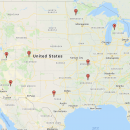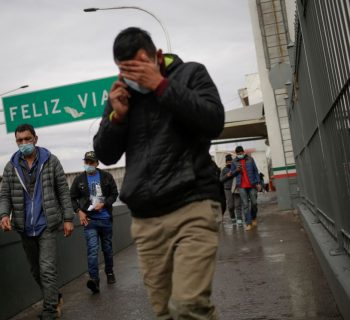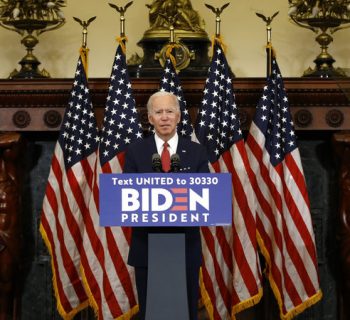Exclusive Op-Ed for El Magonista
By Professor Gonzalo Santos, June 1, 2019
North America is, and has been for decades now, a thoroughly integrated economic zone. Intra-regional trade between Mexico, Canada, and the U.S. dwarfs all other trade the U.S. has with the rest of the world. Recently, with the trade war with China, Mexico became the Number One trading partner of the U.S. And the three countries of NAFTA are poised to enact NAFTA 2.0 - the so-called USMCA trade agreement, known in Mexico as the T-MEC, to bolster and deepen this region's already advanced integration.
Mexico is today, as Canada, economically speaking another vast and integrated productive platform, commercial zone, and consumer base of the U.S. market - two more vital "Californias." To impose unilateral tariffs on Mexico (as past threats to close the border commercially), in legal violation of the actual NAFTA trade regime, to force Mexico to comply with the extreme & draconian U.S. immigration measures directives emanating from the Trump Administration, is as irrational, counterproductive, and in fact illegal, as if Trump unilaterally decreed punitive tariffs on California out of spite to its pro-immigrant state laws and make it bend to cooperate with Trump's anti-immigration initiatives (in flagrant violation, of course, of the "interstate commerce clause" in Article 1 of the Constitution, which grants that power exclusively to Congress).
This reckless action requires explanation, for it threatens to unravel the whole integration process of North America. It needs to be seen - aside the alarming loose-cannon, ill-informed, and rabidly xenophobic nature of the Trump regime - as the inexorable logical endpoint of the asymmetrical architecture and contradictory evolution of North American regional neoliberal integration. For the building of this architecture and contesting its distorted evolution has involved all regional state, corporate, and social actors and agencies, with the relative willful cooperation (and relative resistance) of all political parties and administrations in the three countries, the economic elites and their corporations, and the national labor unions and the migrants themselves. It happened in the Post-World-War II prosperous and optimistic context of implementing and extending the ambitious U.S. New Deal social contract to the region. In Mexico, it meant embarking in its own national industrialization program in partnership with U.S. investments, absorbing all its labor for the task of urbanizing and modernizing the "developing" country.
This explains why the main aspect of North American regional integration that purposely lagged behind all others - emerging regional production chains, regional commerce, unfettered finance & investment, and in recent decades security and environmental regulations - is, precisely labor mobility, especially Mexican labor migration, which, in the absence of a proper regional regulatory regime that aligned with and contributed to the fast regional integration, was artificially "illegalized" on a gigantic scale (largest in the world), creating an increasingly chaotic situation by the 1980s era of conservative Reaganism, and in particular the1990s era of neoliberal NAFTA, when Mexican labor out-migration exploded - precisely as a direct result of the new regional economic regime, which displaced millions of Mexican farmers and kept Mexican urban wages artificially as the lowest in Latin America.
But the crucial fatal mistake of the model of North American integration in the era of U.S. global hegemony had started earlier.
The starting point for adopting a labor-restrictionist approach to integrating the region, though, is 1965 - after the US and Mexico agreed to end the Bracero Program harshly regulating circular and large guest labor migration from 1941 to 1964, and the U.S. Congress, dominated by liberals, passed the most generous, liberal, welcoming immigration law of the century. It had a fatal flaw as it pertained North American integration: while it enshrined the principle of unrestricted (non-quota) family reunification in the granting of legal visas - which ever since has accounted for most legal Mexican migration to the U.S. -, it "capped" all other forms of Mexican migration to an annual national quota of 20,000 LPR visas. This was done in the name of fairness and color-blind equity: all countries were capped with the same quota over the non-quota family visas, and hemispheric and global annual visa quotas were imposed. While it appeared benign, it literally and inevitably created the "problem" of Mexican "illegal alien" migration, given that the previous, well-established pattern of circular Mexican labor migration between the two countries involved about 400,000 migrants per year. Both Mexico and the U.S. concurred this flow would now be absorbed by Mexico's highly-protectionist, national developmentalist program, aided by U.S. foreign investment and technological transfers. The future "granulated" nature of its nationally-segmented labor markets of and otherwise emerging shared regional prosperity was assumed as possible and desirable.
It was a fatal miscalculation, as the dynamics of regional capitalist integration began to show by the mid-1970s.
The intractable, unmanageable, chaotic, and irrational nature of regional migration that has accelerated over the past years is the result. In the U.S., it has produced an ugly white nationalist backlash unseen since the early decades of the past century, when Congress shut immigration entirely (ironically, and thanks to growers' lobbying, exempting the "Western Hemisphere" - i.e., Mexican farm workers). Europe anticipated and attempted to avoid this scenario by regionally integrating its social, migratory dimension along its careful plan for ever-deeper economic integration and less-deep-but-steady political unification processes. That the European Union is now in the throes of right-wing nationalist backlashes - the most salient animating Brexit - does not mean their efforts and vision were misguided, only that they were not sufficiently inoculated from the larger economic contradictions and emerging geopolitical chaos of the post-U.S.-hegemonic period we live in.
North America went in this latest post hegemonic/post cold war period from being the bastion of economic, political, and social stability, global governance, and even relative regional prosperity to ground zero of economic, asymmetrical national and regional dislocations, renewed social polarizations, and disruptive actions undermining world governance. I do not need to recount all the episodes of the present century - the dismantling of the New Deal programs and extreme income inequality throughout the region, the disastrous U.S. wars in the Middle East, the burst speculative bubbles and the 2008 Wall Street meltdown, the resurgence of white supremacy and white nationalism - but certainly on the social front, the "immigration issue" has become *the* most socially and internationally polarizing, intractable, and explosive issue in the region. Given its flawed design and increasingly distorted, unmanageable evolution from 1965 to the present, it has finally reached, in Trump's era, the capacity to seriously undermine the advanced North American economic regional integration itself.
To compound the contradiction between economic North American integration and national compartmentalization/"illegalization" of mobile labor, the collapse of the region of Central America known as the Northern Triangle, after four decades of experiencing the "magic of the neoliberal marketplace" and the consequences of bloody counterinsurgency wars imposed by Pax Americana, what is today flowing to the U.S. southern border is an unstoppable human exodus of displaced, pauperized, refugee families and unaccompanied children. They far supersede the dwindling Mexican labor migration flows, which has actually turned negative in the past decade (more Mexican migrants are leaving the U.S. than are arriving, and the number of apprehended undocumented Mexican migrants is at its lowest since 1970, before it's explosive growth).
The reflexive reaction of U.S. policy makers since 2014 - from the Hillary Clinton/Barack Obama administration to the present Trump one - has been to seek ways to intercept, detain, and promptly return these desperate asylum-seekers. Mexico was enlisted by Clinton/Obama in this efforts during the past Peña Nieto administration. Only because such approach runs afoul national and international asylum laws in both countries, has the flow of refugees continued to grow in size and level of collective defiance - the caravans of the past two years. Mexico is as bound by law to respect the human rights of these refugees as the U.S.
Now Trump has dispensed with previous diplomatic niceties - outsource to Mexico, at a hefty price, the forceful suppression of refugee flows from the Northern Triangle and other regions making their way into Mexico (Haiti, Cuba, Africa) - and demands of the new Mexican government, as well as those of the Northern Triangle, to suppress the flows by their own extra-legal means and at their own expense, or face the suspension of foreign aid and escalating tariffs.
Two things need to be said, aside from the complete disruption to North American integration and the economic health of the two countries involved in the latest Trump tantrum: one is that future large, irregular *Mexican* labor and refugee migration flows, yes, Mexican, may be unleashed and provoked by uncertain global, regional, and national catastrophic developments ahead, or for that matter from other parts of Latin America (the Andean countries, the Caribbean ) and the Global South (Asia & Africa). Not only is the U.S. entirely unprepared to face them under its current national, dysfunctional, immigration regime and the deliberate, foolhardy lack of any regional compact, but may actually generating these flows by its own aggressive foreign policies & neomercantilist trade wars. It goes without saying that the domestic social polarization and conflict this will engender will destabilize the social peace of the country as well. The urgency for adopting an entire new migration compact for North America, in tandem with an improved project for symmetrical, equitable, and sustainable regional integration, cannot be overstated.
The other one is that, though the conundrum of North American incomplete and now-threatened integration has roots in liberal visions of a shared, capitalist development among neighboring countries in the apogee of U.S. global hegemony, the present sabotage of that vision and even its vital economic advances by the assertion of an aggressive and reactionary nationalism, represents the rise of a neofascist project, in the U.S. and other Western sites, that goes well beyond migration/refugee issues, and ethnic/racial concerns, and include reasserting global and domestic class and geopolitical hierarchies with a vengeance in an era of the rise of East Asia (China). In that light, the draconian suppression of intra-regional migration flows in North America by the Trump administration pales in comparison with the demise of American democracy, the suppression of civil liberties and labor rights, and the rise of a American fascism that threatens the world.
The strategic importance of the North American regional immigration issue, nevertheless, lies in that the rise and entrenchment of Trumpism to power is mostly predicated as the sole, resolute defense of the besieged United States from the invading hordes of dark, criminal aliens bent of destroying it. That is, Trumpism relies on xenophobia to accumulate and centralize power in the same way that Nazism did relying on anti-Semitism. And given the deeply-flawed migration regime that has now been universally deemed "broken," the U.S. is particularly vulnerable to the siren songs of white nationalism.
To the degree that social forces - U.S. and regionally - contesting Trumpism dare to articulate, champion, and implement - not ignore or evade - a bold new vision of North American integration with a social component, to supersede the present one focused entirely on economics, to that degree they may deny U.S. neofascism its main source of social fuel: racist xenophobia. It is in this sense that the present rejection by the Mexican and Central American government of Trumps blatant threats of tariffs and other punitive actions need to be supported - and not just by the Mexican and Central American peoples, but by their immigrant diasporas in the U.S., by all Latino ethnic communities, and by all progressive social forces in the United States and the region.
But, above all, what needs to emerge in the heat of the battle for our common future is a blue print of a better model of North American integration, one with an inclusive, regional, transnational social dimension that allows for regional mobility as that in Europe, that can set the foundations for a truly prosperous and balanced regional economic integration process in the decades ahead; and, in so doing, contribute strategically to defeat U.S. neofascism in its own ideological terms - reactionary, racist nationalism and naked ethnoclass (white American) rule.







